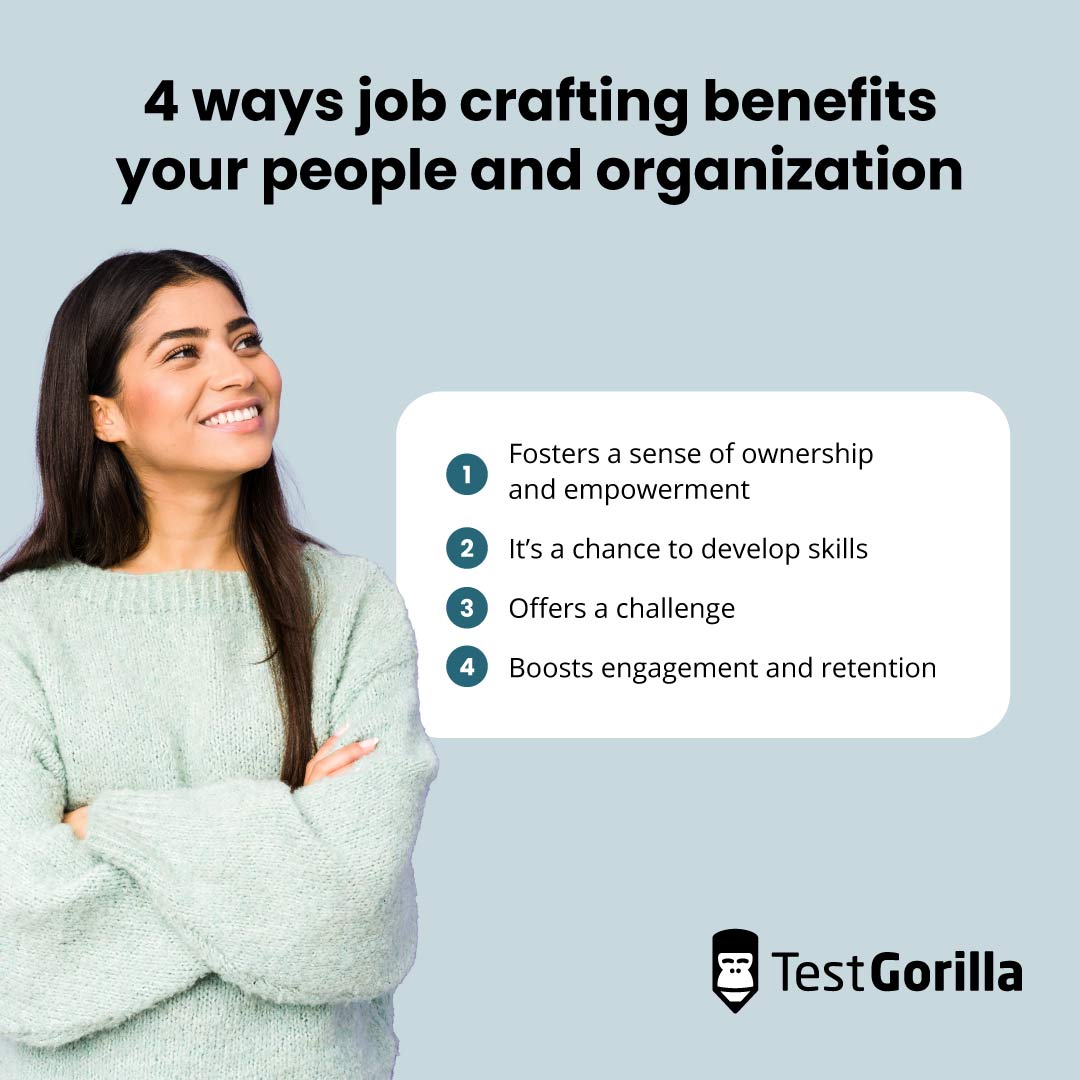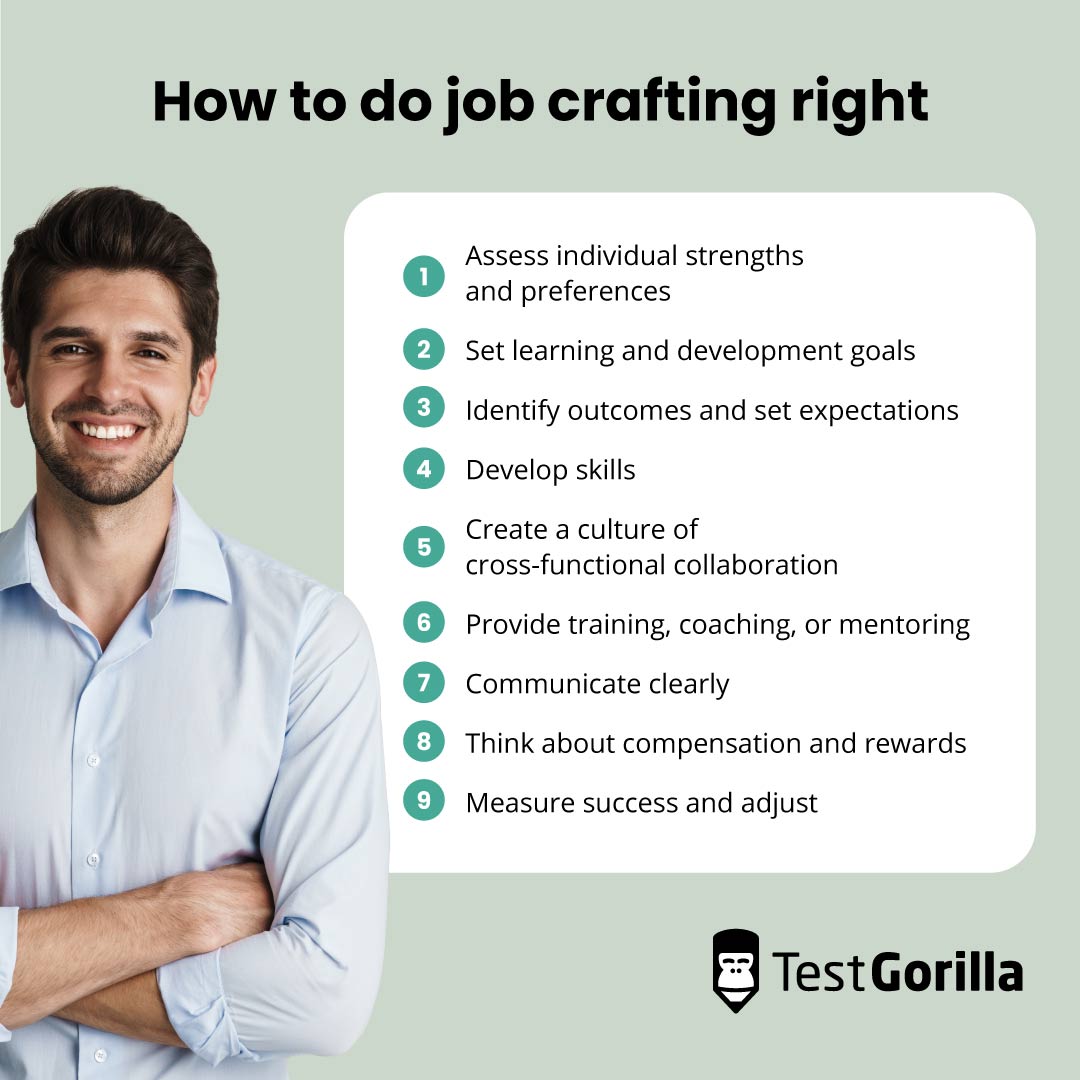After a few years at your company, business development representative (BDR) Alisha isn't feeling fully satisfied with her current role. However, she appreciates the company culture, values her colleagues, and believes in the company's mission.
Alisha wants to stay within the company but would love for her role to align more closely with her passions and strengths: being a good networker and relationship builder. While being a BDR offers elements of that, she’s not loving the regular rejection involved in cold-calling sales prospects.
After speaking with Alisha, you realize she could be HR-adjacent, so you want to help her proactively modify her role. You believe this “job crafting” can help increase her engagement and skills development, and reduce the risk of losing a great team member.
However, there are challenges to allowing employees to modify their roles, such as work overload and burnout, loss of alignment with company goals, or impact on performance. This means you need a way to measure her skills and progress against future growth plans, and to make any adjustments to her learning and development goals to help her stay on track.
In this post, we’ll look at the benefits and challenges of job crafting, and how organizations can support it. We’ll also explore the benefits of skills development and how to use talent assessments to identify skills gaps and develop the capabilities employees will need when expanding their roles.
Table of contents
What is job crafting?
Job crafting is the process by which employees proactively modify their roles.
"Most job descriptions have some leeway when it comes to responsibilities," says Nathan Brunner, chief executive at Salarship. "Job crafting is when an employee takes advantage of this flexibility to reshape their job and adapt it to their skills, passions, and goals."
This might include how employees approach and execute their day-to-day tasks or how they interpret their overall responsibilities
For example, a marketing content writer might take on additional responsibilities related to search engine optimization strategy, benefiting the company’s clients and developing the writer’s skills.
Nathan explains: "We had two content marketers for our career advice blog. They initially shared similar responsibilities but, with time, one specialized in topics research while the other became a wordsmith, which improved the blog significantly."
This level of autonomy can increase engagement and alignment with organizational goals and benefit retention, skills development, and employee well-being. Let’s take a closer look at some of these advantages.
4 ways job crafting benefits your people and organization
From increased job satisfaction to improved performance, job crafting has many benefits for your people and business.
1. Fosters a sense of ownership and empowerment
When employees have a hand in shaping their roles, they are more motivated to excel and take accountability for what they're doing. This can help them find meaning and purpose in their work, leading to higher levels of engagement and empowerment to do their jobs.
2. It’s a chance to develop skills
Job crafting offers a chance to develop skills. Experienced employees with longer tenure in particular can get to a point where they plateau and don't progress. As a result, the skills they had when they entered the organization may no longer be as useful to the company, which can result in them being forced out or leaving. For example, in the case of older workers who fail to acquire in-demand digital skills.
By giving people more ownership of skills development, job sharing can help you reskill and upskill employees, which offers opportunities for internal mobility. This can inspire your team to be more productive, find a greater sense of belonging, and close important skills gaps that keep your business competitive.
3. Offers a challenge
Job crafting encourages employees to step outside their comfort zones, learn new skills, and explore new areas of responsibility. It's also an opportunity for your team to stretch themselves, which might lead to obstacles or failure but can also lend itself to new discoveries and innovation.
4. Boosts engagement and retention
According to key psychological research, job crafting has a positive correlation with multiple markers of employee well-being. These include engagement, job satisfaction, and a sense of belonging.[1]
When people value their role and actively shape it to build more meaningful experiences, they're more interested in their work and want to stick around longer.
Case study: Google's "20% Time" Policy
Google's 20% philosophy encourages employees to spend 20% of their work time on projects of their choice, unrelated to their main job responsibilities. This includes anything from fixing bugs to trying out tasks that aren't in their job description.
Giving employees the freedom to craft their roles and work on projects they're passionate about has led to the development of innovative products such as Gmail and Google Maps.
What are the challenges of job crafting?
Now that you know the benefits of job sharing, let's explore some common challenges so you can better anticipate employees’ needs as they transition.
Overload and burnout
Employees may inadvertently take on too many responsibilities or stretch themselves too thin while taking on additional tasks. This can lead to burnout and reduced performance.
Additionally, crafting a job in itself can be time-consuming, and people may struggle to balance their existing workload with the additional effort required to redefine their roles.
Loss of alignment
Over time, the alignment between an individual's crafted job and organizational objectives can shift, which can affect your ability to meet company goals.
You might also encounter resistance from supervisors or colleagues when attempting to modify existing roles. This can stem from concerns about the impact of changes on team dynamics or work processes.
Hierarchical conflicts
Job crafting may cause conflicts when employees' modified roles overlap with their superiors or when there are differences in expectations about responsibilities. This is something to be particularly sensitive to when managing multi-generational teams where older generations expect people to have to “climb the ladder” to reach a position similar to theirs.
"You want to make sure employees don't inadvertently cannibalize each other's duties. When employees take the initiative to better shape their roles to suit their skills and interests, there's a risk that the redistribution of responsibilities could lead to overlapping or conflicting tasks." - Nathan Brunner, chief executive at Salarship.
Establishing compensation
It can be difficult to establish compensation when employees are crafting new positions with a mix of responsibilities.
Additionally, If people are doing more, they may expect to be paid more. This is especially true if, through job crafting, they become more valuable to the organization.
How to do job crafting right
There's no one-size-fits-all approach when it comes to crafting the right job with your employees.
However, there are some best practices you can steal to help your team build a stellar career portfolio that better matches their strengths and skills. Let's get started:
1. Assess individual strengths and preferences
To craft a job that suits your employees, you first need to understand what they're interested in and what skills or strengths they want to develop.
Here's how:
Get 360-degree feedback. Set up a feedback process where team members receive input from supervisors and direct reports. Peer-to-peer feedback can also help identify strengths and areas for improvement from multiple perspectives.
Use personality tests. Big 5 (OCEAN), DISC, Enneagram, and 16 personalities tests, among others, can give you insights into team members' personality traits, communication styles, and working preferences. Job motivation tests also let you check whether their skills and passions are aligned with their role.
Schedule regular 1:1 meetings. During the meeting, ask open-ended questions to learn about employee career aspirations, preferred work tasks, and areas where they feel most confident and motivated.
2. Set learning and development goals
Job crafting often involves expanding your skill set to take on new responsibilities or modify existing tasks. Setting learning and development (L&D) goals allows employees to acquire the skills necessary for their crafted roles, making them more effective in their work.
Here are some ways to set meaningful development goals:
Use the SMART criteria to structure your goals. This means specific (clearly define what you want to achieve, measurable (determine how you will measure progress), achievable (realistic, attainable goals), relevant (aligns with aspirations and job responsibilities), and time-bound (set a timeframe for achieving the goal).
Set long- and short-term goals. Short-term goals can act as stepping stones toward long-term success and help keep you motivated.
Leverage resources. Identify the resources and support you need to achieve your goals. This might include training programs, courses, mentors, or networking opportunities.
Measure progress. Establish clear metrics and milestones to track your progress. Regularly assess how far you've come and adjust your approach as needed.
3. Identify outcomes and set expectations
Successful job crafting is built on preparation. Have conversations around outcomes and expectations early on in the job crafting process. This can help provide clarity on what employees aim to achieve through this process and help them stay focused and purpose-driven.
When modifying roles, it's important to ask questions like: What will you both get out of it? How will you measure success?
By diving into potential outcomes and motivations, you can provide a solid framework for growth that can also be adjusted as circumstances change. This ensures that job crafting efforts remain relevant and effective over time.
4. Develop skills
For younger generations especially, skills development and growth opportunities are key considerations when it comes to choosing an employer.[2]
Moreover, companies with a strong L&D culture are 52% more productive and 56% more likely to be the first to market with products and services. Their engagement and retention rates are also 30–50% higher.[3]
You can develop your people's skills and reward and retain talent by using talent assessments. These tests help identify skills gaps and develop the hard and soft skills employees need when expanding their roles. For example, you can test for skills like open communication, active listening, and openness to feedback, as well as hard skills like product marketing management or internal auditing.
5. Create a culture of cross-functional collaboration
Cross-functional teams bring a diversity of perspectives, which can help your teams tackle complex problems and find creative solutions, faster.
To create a strong culture where different teams and departments work together, you can:
Create open communication channels. Foster open and transparent communication channels across functions. Encourage employees to share information, insights, and updates regularly. The right digital environment goes without saying: Collaborative tools like Slack, Asana, Google Workspace, and Notion can significantly boost internal comms.
Form cross-functional teams to tackle specific projects or initiatives. These teams should be composed of members from different departments with a range of skill sets, and have clear objectives and timelines.
Celebrate achievements. Recognize and reward individuals and teams for successful cross-functional collaboration. Acknowledge their contributions to fostering a collaborative culture on your shared communication channels or in your newsletter.
6. Provide training, coaching, or mentoring
As part of skills development, people need the opportunity to exercise and apply those new skills. This means offering various learning methods such as workshops, courses, seminars, webinars, e-learning modules, and on-the-job training.
Personalized coaching and mentoring programs can also offer valuable insights and practical advice to employees expanding their roles. Individuals are more likely to follow through with their job crafting plans when they know they have someone to report progress to and get guidance from.
7. Communicate clearly
Timely communication helps ensure everyone knows what's going on. It’s important to avoid the impression that you’re promoting someone over others or fast-tracking them. These and other perceptions could cause friction on the team.
Here's how you can communicate more effectively when it comes to job crafting:
Encourage open dialogue. Foster an open and inclusive environment where team members feel comfortable discussing their career aspirations, strengths, and areas for development. This can be done through team building exercises, games, and events.
Engage in active listening. Actively listen to your team members' input and concerns. Pay attention to their ideas, suggestions, and feedback. Validate their perspectives and acknowledge their contributions.
Provide regular updates. Maintain regular communication about the progress of job crafting initiatives, including any changes in roles or company structure.
Know how to handle conflict. Be prepared to address any conflicts or challenges that may arise during the job crafting process. Promote constructive conversations and help team members find solutions.
Share best practices. Encourage team members to share their successful job crafting experiences and best practices with colleagues. Peer sharing can inspire and guide others.
8. Think about compensation and rewards
As mentioned above, establishing compensation and rewards can become tricky when people take on new responsibilities, especially when they're technically still working in the same position.
To address compensation, start by ensuring that the process is fair, transparent, and aligned with both individual and organizational goals. This involves understanding the motivations of employees who are engaging in job crafting.
What are their career aspirations, personal goals, and the specific changes they are making to their roles? This insight will help you tailor compensation and rewards to their unique needs. For example, you can offer rewards and compensation based on skills development, increased responsibility, and perks related to work-life balance, depending on what the employee prioritizes.
Pro tip: Use our Motivation test to help you understand what's driving employees during hiring and job crafting, and get direct insights into improving the employee experience.
9. Measure success and adjust
The goals you set for job crafting need to be top of mind during the transition. This will allow you to track progress and know how close you are to achieving them. This also includes evaluating key performance indicators like employee satisfaction, engagement, and retention.
You should also regularly collect data and feedback from employees and managers to track their achievements, challenges, and experiences related to job crafting. You can do this by conducting surveys, interviews, or focus groups to understand their perspectives, needs, and perceptions of success.
Finally, use talent assessments to measure acquisition of new skills or the development of existing ones resulting from job crafting efforts. This can help you spot new areas for improvement and give you ideas for future job crafting opportunities.
Job crafting: A unique opportunity to develop skills and grow
To maintain a strong company culture and retain skilled talent, you need to offer the kind of flexibility that keeps employees engaged and morale high.
Job crafting provides a flexible and adaptable solution that enables employees to thrive in changing circumstances. By allowing individuals to reshape their roles to align with their strengths, interests, and goals, job crafting can enhance job satisfaction, engagement, and overall well-being. It also fosters a sense of ownership and purpose, leading to increased motivation and productivity.
However, job crafting isn’t without its challenges, like avoiding burnout and peer concerns. It’s all about finding that sweet spot where individual fulfillment and organizational success intersect.
You can start by:
Assessing individual strengths and preferences
Setting learning and development goals
Identifying outcomes and setting expectations
Developing skills
Creating a culture of cross-functional collaboration
Providing training, coaching, or mentoring
Communicating clearly
Thinking about compensation and rewards
Measuring success and adjusting
Once you've done this, use talent assessments to identify skills gaps, measure, and develop the skills job crafting employees will need to successfully modify their role – and bring value to your team and company.
Engage employees through skills development. Talent assessments let you measure current and in-demand skills and identify opportunities for employee growth. |
Sources:
"Job Crafting and Work Engagement: The Mediating Role of Work Meaning." (2021). The National Library of Medicine. Retrieved September 21, 2023. https://www.ncbi.nlm.nih.gov/pmc/articles/PMC8158331/
"2023 Gen Z and Millennial Survey." (2023). Deloitte. Retrieved September 21, 2023. https://www.deloitte.com/global/en/issues/work/content/genzmillennialsurvey.html
"Becoming irresistible: A new model for employee engagement." (n.d). Deloitte. Retrieved September 21, 2023. https://www2.deloitte.com/us/en/insights/deloitte-review/issue-16/employee-engagement-strategies.html
Related posts
Hire the best candidates with TestGorilla
Create pre-employment assessments in minutes to screen candidates, save time, and hire the best talent.
Latest posts
The best advice in pre-employment testing, in your inbox.
No spam. Unsubscribe at any time.

Hire the best. No bias. No stress.
Our screening tests identify the best candidates and make your hiring decisions faster, easier, and bias-free.
Free resources
This checklist covers key features you should look for when choosing a skills testing platform
This resource will help you develop an onboarding checklist for new hires.
How to assess your candidates' attention to detail.
Learn how to get human resources certified through HRCI or SHRM.
Learn how you can improve the level of talent at your company.
Learn how CapitalT reduced hiring bias with online skills assessments.
Learn how to make the resume process more efficient and more effective.
Improve your hiring strategy with these 7 critical recruitment metrics.
Learn how Sukhi decreased time spent reviewing resumes by 83%!
Hire more efficiently with these hacks that 99% of recruiters aren't using.
Make a business case for diversity and inclusion initiatives with this data.






















